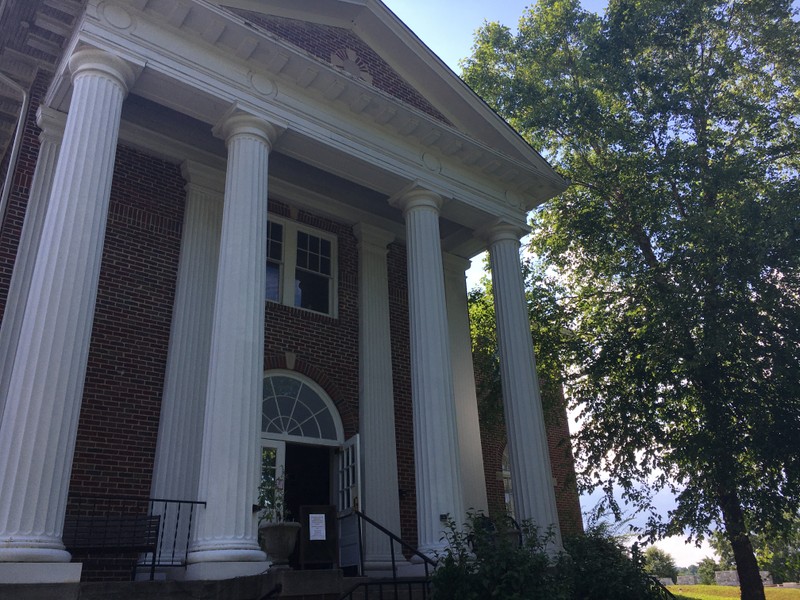Davenport College
Introduction
Text-to-speech Audio
The building that now houses the Caldwell Heritage Museum is the last remaining building of Davenport College. The institution allowed for the education of young woman, and later young men, in Lenoir from 1855 until its merge with Greensboro College in 1933. Sitting atop a hill overlooking Lenoir and now neighboring Davenport Elementary School, the brick building that remains is one of three that were built after a fire destroyed the first school buildings 1877. In 1933, the buildings were transferred to the ownership of the Lenoir City School system. Two of the three buildings were demolished, and the third was obtained by the Caldwell County Historical Society. It opened as a museum in 1991 and remains so today.
Images

Backstory and Context
Text-to-speech Audio
Davenport College was established in 1855 as a woman’s college under the Presbyterian denomination. It was erected on land given by W. A. Lenoir and James C. Harper, and was named for William Davenport, who contributed the most funds to build the school. In 1857, it was placed under the South Carolina Conference of the Methodist Episcopal Church and was chartered by them in 1859.
When it first opened, the school had fifty-six students and consisted of a classroom building, a chapel, and a dormitory. The main building was impressive. It was two and a half stories high and made of brick. There were columns at the entrance and an observatory in the loft. The institution held learning in high esteem. In 1861, they stated their aim as “Pupils will not be hurried through a superficial course of study, but such as a systematized plan pursued, as is well calculated to lead to gradual and complete development of all the powers of the mind.”1
During the Civil War, the school remained open, though attendance dropped. At the close of the Civil War, classes were suspended. At that time, General Stoneman came through Lenoir on his raid through western North Carolina. His army took possession of the campus. Though the building remained standing, much property such as books, musical instruments, and furniture was defaced or destroyed. Across the street, Saint James Episcopal Church was used as a hospital and prison by General Stoneman.
Following the Civil War, classes resumed. However, in 1877, disaster struck. That February, a fire destroyed Davenport Female College. There was no insurance to cover the loss, yet, the very next day, a decision was made to rebuild the school. The new building was finished by 1884; however, the school was no longer supported by the Methodist conference. It functioned as a private high school for a few years before becoming a college again. In 1899, the Methodist conference again supported it. Shortly after this time, the school added more buildings and modern equipment. This helped increase enrollment.
The Great Depression, however, took a toll on the college, and in 1933, Davenport College closed. A decision was made in this year by the Western North Carolina Conference of the Methodist Church to merge Davenport College with Greensboro College. The buildings and property were transferred to Lenoir City Schools. The two buildings were used as a junior high school.
In 1986, one building remained. This building was erected in 1926 and once housed the auditorium and music rooms of the college. The building was scheduled for demolition. However, the Caldwell County Historical Society acquired it. The society restored the building and transformed it into a museum. Today, the museum functions to preserve and teach the history of Caldwell County, North Carolina. Beside the museum sits Davenport Elementary School. Its name is a remnant of the college that once stood there to provide education for young women and men of Lenoir.
- Quoted in John O. Hawkins, “Echoes from the Hill: A Brief History of Davenport College,” Davenport A+ Elementary, Accessed 13 April 2022, https://www.caldwellschools.com/Page/11296. Primary source was not named in the essay.
Sources
Caldwell Heritage Museum. “Home.” Accessed 13 April 2022. http://caldwellheritage1841.weebly.com/.
Cross, Jerry L. “Davenport College.” In Encyclopedia of North Carolina, edited by William S. Powell. Chapel Hill: University of North Carolina Press, 2006. NCpedia. https://www.ncpedia.org/davenport-college.
Hawkins, John O. “Echoes from the Hill: A Brief History of Davenport College.” Davenport A+ Elementary. Accessed 13 April 2022. https://www.caldwellschools.com/Page/11296.
Marker: Raiders in Lenoir: St. James Episcopal Church and Prison: Stoneman’s Raid. Williamsburg: Civil War Trails, Inc., 2008. North Carolina Digital Collection. https://digital.ncdcr.gov/digital/collection/p15012coll8/id/10962.
North Carolina Department of Cultural Resources. “Marker N-30.” North Carolina Highway Historical Marker Program. Accessed 13 April 2022. http://www.ncmarkers.com/Markers.aspx?MarkerId=N-30.
